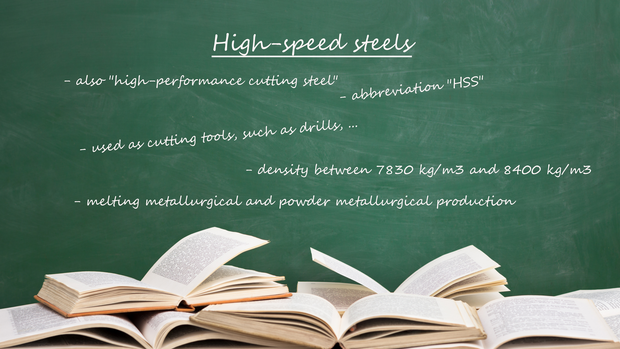Properties of High-speed steels
High-speed steels are also called "high-performance cutting steel".
Therefore, the abbreviation "HSS", is also frequently used. High-speed steels are a greyish material,
which has external, noticeable characteristics such as smoothness, hardness and coldness.
High-speed steels are alloyed tool steels with a carbon content of up to 2.06% and
up to 30% of an alloying element. An alloying element can be, for example, nickel, titanium or tungsten.
High-speed steels also have high tempering resistance and wear resistance,
as well as a heat resistance of up to 600°C. They are more resistant to corrosion with coatings.
With coatings, they are more resistant to corrosion and, due to their properties,
largely insensitive to shocks and vibrations, which can lead to fractures in harder materials to be machined.
The density of high-speed steel is between 7830 kg/m3 and 8400 kg/m3.
Furthermore, in the soft annealed state, good machining (milling, turning, drilling or grinding)
of this material is possible. It is chipless and can be cold- and hot-formed. However,
high-speed steels are not weldable. Due to the above-mentioned properties,
high-speed steels have a higher cutting speed.
Two different methods can be used for the production of high-speed steels, the melting metallurgical and the powder metallurgical production. In the melting metallurgical production, steel is melted and an alloying element is added. This is now cast into ingot form and block annealed, to distribute low-melting components evenly. This is followed by rolling and forging to bring the shape. In powder metallurgical production, there are again two methods, gas atomisation and water atomisation, which are then subdivided again. In gas atomisation, the powder is in capsules which are then pressed at high temperatures and constant pressure.
Next comes hot forming (rolling, forging), machining and heat treatment. The first method in water atomising: is cold isostatic pressing at room temperature. Here, porosity still remains in the steel. Then comes sintering, where the product is annealed just below melting temperature. This is also followed by rolling, forging and heat treatment. In the second method, pressing, powder is pressed and fully compacted. It is then re-compacted at high temperature and constant pressure and finally goes into heat treatment, where no rolling or forging takes place. They are then hardened at 1200°C to 1300°C and tempered several times at around 500°C.
They are then hardened at 1200°C to 1300°C and tempered several times at around 500°C. This increases the hardness and is called heat treatment. High-speed steels are used as cutting tools, such as drills, threading tools, saw blades, milling cutters or turning tools. They are also used as tools for machining or forming.


